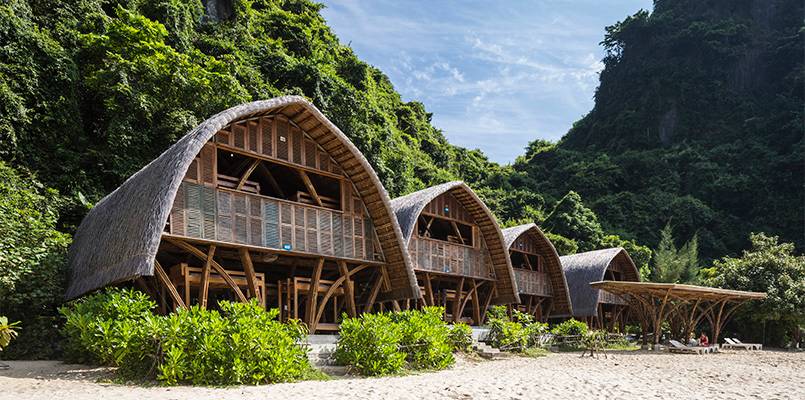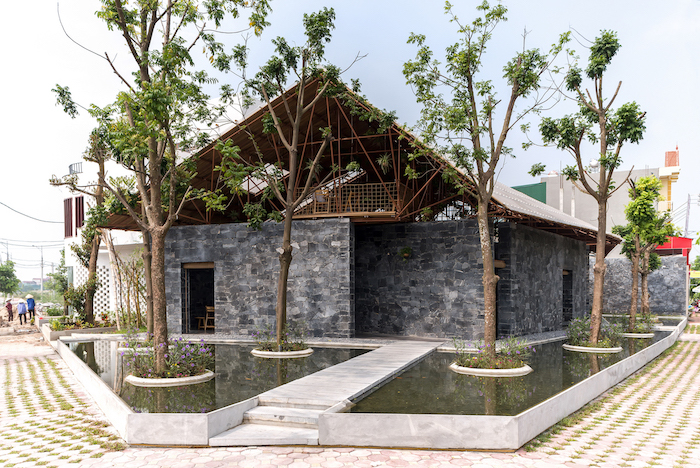Snapshot: Bamboo & brick in Vietnam
April 15, 2021
When one thinks about traditional Vietnamese architecture now, one might think bamboo is the archetypal material used. If one were to have a quick look at projects highlighted in recent years from Vietnam, one could be forgiven for this assumption. This is perhaps contributed in no small part by architects such as Vo Trong Nghia who has—dare we say—revolutionised the use of bamboo in Vietnamese architecture in the past few years.
Castaway Island
Naman Retreat

Castaway Island 
Castaway Island 
Naman Retreat
Calling it the ‘green steel of the 21st century’, Vo has said, “Bamboo is bendable. This is an important character. Using bent bamboos, the structure obtains unique shape and beauty. With proper treatment—soaking in mud and smoking it—bamboo becomes as durable as timber.”
And bend them he did. The way bamboo has been applied—as seen in these two projects for example—one would think it is the most malleable material in the world. Notwithstanding, his use of bamboo is both awe-inspiring and a splendid sight to behold.
Other architects like H&P Architects have also used bamboo in different but equally impressive ways that showcase the durability and resilience of the material.
READ MORE: Toigetation
READ MORE: S Space
Historical architecture in Vietnam, however, is more similar to those of its regional neighbours in China and Thailand—with wooden structures and steep roofs—like those of ancient temples. Bricks were commonly used because they are inherently a Vietnamese material, indigenous to the area.
READ MORE: Termitary House

Termitary House 

READ MORE: Maison T
Thus, many Vietnamese buildings today still use bricks as their main material. The good thing about brick, climatically for Vietnam, is it does not retain heat; it insulates against it, and its porous nature helps retain early morning moisture that evaporates to cool in the midday. In more modern-day Vietnamese interpretation, several architects have used bricks in creative ways, both to enhance its characteristics in terms of climate adaptiveness and eco-friendliness, as well as a cultural symbol of local craftsmanship and finesse.
READ MORE: Viettel Academy Educational Centre
READ MORE: Brick Cave
Many of these projects have been recognised internationally due to the way brick has been assimilated into the building design to highlight both the beauty of the raw material and the elegance of artistry, especially when used as latticed screens or walls. Not only do they keep the buildings naturally ventilated and daylit, they are aesthetically pleasing and exude a sense of cosiness, especially suitable for homes.
READ MORE: The Red Roof

The Red Roof


READ MORE: Homefood
Since it is indigenous to Vietnam, bricks are affordable and easy to acquire, thus making it an attractive, uncomplicated material, both in terms of cost and environmental impact, supporting the building and design of humble abodes or offices. And when one considers the narrow typology of most residences in the cities—tube houses—bricks have become a popular option too for local designers to explore when they want to create interesting façades for these traditional houses.
READ MORE: VH HOUSE
Bamboo for Construction Innovations
To read the complete article, get your hardcopy at our online shop/newsstands/major bookstores; subscribe to FuturArc or download the FuturArc App to read the issues.
Previously Published Commentary, Online Exclusive Feature
Contact us at https://www.futurarc.com/contact-us for older commentaries.

